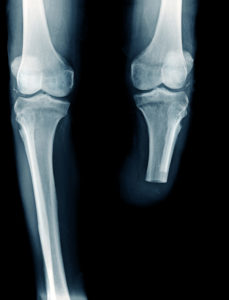
A new meta-analysis, just published in the Journal of Vascular and Interventional Radiology (JVIR), suggests significantly reduced amputation-free survival at one year when paclitaxel-coated balloons are applied in arteries below the knee for critical limb-threatening ischemia (CLTI) treatment, but some experts advise cautious interpretation of results and question whether these data will impact practice. The new systematic review and study-level meta-analysis of eight randomized controlled trials was conducted by Konstantinos Katsanos, MD, assistant professor in the School of Medicine, University of Patras, Patras, Greece, and colleagues.
Several physician thought-leaders believe that the conclusions are not yet definitive, with multiple peripheral vascular interventionalists cautioning how these data should be interpreted. Most emphasized the challenge of teasing out scientifically meaningful information from a patient cohort that suffered from CLTI, which is associated with “mortality, amputation, and impaired quality of life.” They also point to the inclusion of unpublished data (which has therefore not gone through the peer-reviewed process); the inclusion of summary-level data; the inclusion of the IN.PACT DEEP data (which used a device that has long since been withdrawn from the market); and the study’s short-term follow-up period.
As reported in JVIR, the eight randomized controlled trials included in this most recent summary-level analysis included 1,420 patients, of which 1,380 (97.1%) had CLTI. The primary safety and efficacy endpoint was amputation-free survival, defined as freedom from all-cause death and major amputation (above the ankle). At one year, there was a 13.7% crude risk of death or limb loss among the 835 patients who had received treatment with paclitaxel-coated balloon—74 deaths and 40 major amputations. In comparison, the crude risk of death or limb loss in the cohort treated with an uncoated balloon was 9.4%—39 deaths and 17 major amputations. For the primary amputation-free survival endpoint, the number needed to harm was estimated to be 22 patients (95% confidence interval [CI] 11–94). The authors claim there was consistent evidence from the randomized studies that freedom from major amputation or death was significantly lower in cases with paclitaxel-coated balloons with a pooled hazard ratio (HR) of 1.52 (95% CI 1.12–2.07; p=0.008).
However, Katsanos et al also report consistent evidence that paclitaxel reduces the need for target lesion revascularization in below-the-knee arteries by approximately 40%. Target lesion revascularization constituted the secondary efficacy endpoint. The crude risk of target lesion revascularization was 11.8% (103 revascularization events among 875 cases) versus 25.6% (159 events among 620 control patients) for patients treated with a paclitaxel-coated balloon and an uncoated balloon, respectively. The calculated pooled risk ratio was 0.53 (95% CI 0.35–0.81; p=0.004), with a corresponding number needed to treat of eight patients (95% CI 4–25).
The study authors claim there is a dose–response relationship between paclitaxel and amputation-free survival. They compared outcomes with low and high doses of paclitaxel, and found significantly more deaths or amputations (lower amputation-free survival) in cases with high-dose devices, defined as 3–3.5µg/mm2 (HR 1.62; 95% CI 1.16–2.27; p=0.005). In comparison, amputation-free survival was higher (fewer deaths or fewer major amputations) when a low-dose device (2µg/mm2) was used (HR 1.06; 95% CI 0.48–2.34). This low-dose was found to be safe and effective, the authors report.
The authors of the present study say they performed a “comprehensive literature review” due to the “major concerns about systemic safety of paclitaxel” prolific in the endovascular community today as a result of their earlier meta-analysis published in the Journal of the American Heart Association (JAHA) in 2018. This concluded that there was an increased association of mortality beyond two years through five years of follow-up when paclitaxel-coated balloons and paclitaxel-eluting stents were used in the femoropopliteal arteries.
Concerns of the medical community: The vascular surgeon perspective

Kim Hodgson, MD, president of the Society for Vascular Surgery (SVS); Southern Illinois University School of Medicine, Springfield, Illinois
“While this analysis of the efficacy and mortality of paclitaxel use in the infrapopliteal CLTI population has similar methodological limitations to the first Katsanos publication of paclitaxel used to treat claudication, it also reaches the similar concerning conclusion that paclitaxel use in peripheral vascular disease is associated with increased mortality. But this time the authors use the most relevant of clinical endpoints for this population—amputation-free-survival—to evaluate for the ultimate goal of an intact living patient. While it took use of this composite endpoint to achieve statistical significance, it is alarming that both mortality and amputation came very close to independently reaching statistical significance (p=0.1; p=0.09, respectively), and I suspect that with a larger sample size one or both they may have. If further evidence confirms either that paclitaxel does not decrease the rate of amputation but does increase the mortality, then the prospects for its continued use appear bleak. The possible ray of sunshine in this cloud is the observation that the lowest dose paclitaxel device analyzed (Lutonix, BD) appeared to be free of increased mortality yet still effective, perhaps indicating that the dosing sweet-spot has yet to be found while acknowledging that we have no accurate way of measuring actual paclitaxel tissue delivery or systemic release. The complicated nature of paclitaxel delivery and its pharmacology, however, portend that this will remain a complicated mystery to unravel.
“There has been a significant shift towards the use of paclitaxel delivering devices in treating peripheral vascular disease since their introduction several years back. Given this and the ever-growing population of peripheral vascular disease patients being treated, it is critical that physicians know the full risk:benefit profile of the therapies they employ and always put the patient’s outcome first. The methodological limitations of this pooled analysis are divulged by Katsanos and are similar to those of his previous publication on the use of paclitaxel in the claudication population. Nonetheless, his prior report called attention to a signal that was, in fact, subsequently confirmed, though still not understood, so the findings of this analysis are highly relevant and need further analysis.
“When considering a risk like mortality, erring on the side of caution only makes sense, especially considering the multitude of other revascularization options available to most patients, the irreversibility of death, and the risk of litigation. This is especially true when the effectiveness of the therapy itself is in question, as this analysis has suggested. Until we have greater clarity on the safety and efficacy of paclitaxel devices, I believe that most will opt to use them very selectively in the small subset of patients at high risk for restenosis and no other reasonable revascularization options.”

Ramon Varcoe, Prince of Wales Hospital and University of New South Wales, Sydney, Australia
“My first reaction was that it was good to see a group looking to define the risks of paclitaxel devices in the CLTI population. The CLTI group is very different to the claudicants evaluated in the previous meta-analysis and warrants specific attention.
“My reaction to the results was mixed. The authors showed no difference in all-cause mortality or major amputation rates but when they combined the two as the endpoint amputation-free survival, they appeared to find a difference between drug-coated balloons and percutaneous transluminal angioplasty, with better amputation-free survival in the control group. The other positive finding was that they showed a 47% reduction in reinterventions, underlining the well-established effectiveness of these devices.
“It must be said from the outset that—with limited numbers and such short-term follow-up—care must be taken not to overreach in our conclusions. Moreover, taking a deeper dive into the meta-analysis revealed several methodological questions and important validity concerns.
“For example, why were only drug-coated balloons evaluated and not drug-eluting stents? This differed from the methodology of the previous meta-analysis and meant excluding the PADI trial, which has published five-year follow-up. This is the very group identified in the previous meta-analysis as having the most pronounced safety signal. Second, why was amputation-free survival determined to be the primary endpoint, when all-cause mortality was used in the previous meta-analysis? Why was no protocol published on the PROSPERO database to assure the reader that the endpoint was determined a priori, not after the analysis? Third, why were only below-the-knee studies included when the authors speculate it is the particulate embolization of the drug that provides an explanation for the safety signal? Particulate embolization is known to occur when CLTI patients are treated for above- and below-the-knee disease. However, ultimately these are questions for the authors, which may have a reasonable explanation.
“My major concern is the inclusion of unpublished data. This was the case in three of the eight studies pooled. We must take great care in including data that has not been peer reviewed. It is common that event rates change between presentation and final publication, which may alter the findings of a meta-analysis and its conclusions. This is particularly true for low-frequency endpoints such as amputation-free survival at six to 12 months. It is also very difficult for the reviewers to grade the quality of evidence from a short congress presentation, as opposed to a peer-reviewed manuscript. However, including unpublished data is not unheard of, particularly when there are few published studies in the literature. What concerns me most is the glaring omission of the most significant study of drug-coated balloon use in below-the-knee arteries of CLTI patients. The five-year results of the IN.PACT DEEP study were presented by Thomas Zeller at the AMP [Amputation Prevention] symposium last year (14–17 August, Chicago, USA). Like the other three studies, it was unpublished in September 2019 when the systematic review was conducted. However, if you include some unpublished data you must include all.
“IN.PACT DEEP was a rigorously conducted trial that fulfilled all of the inclusion criteria for the meta-analysis, as evidenced by inclusion of its earlier 12-month results. In that study, amputation-free survival was numerically better in the drug-coated balloon group (drug-coated balloon 135/239 [56.5%] vs. percutaneous transluminal angioplasty 65/119 [54.6%]). The inclusion of such a study is important for two reasons. It provides long-term follow-up, which was linked to mortality in the original meta-analysis in claudicants and it had a high number of events (death and amputation). Statistically, meta-analysis gives additional weight to large studies with high event rates because observed differences are less likely to be due to chance. It is my view that if those contemporary results had been included in this meta-analysis, the conclusions regarding amputation-free survival and safety would have been very different. Given the reintervention reducing benefit of drug-coated balloons, the authors have demonstrated we must get this right. A serious omission such as this must be corrected if we are to determine the truth—our very patients’ lives depend on it.
“These results are under a cloud due to methodological questions and the omission of the most important study. This should not impact anyone’s practice until those issues have been addressed.”

Michael Conte, MD, Heart and Vascular Center, University of California, San Francisco, San Francisco, California
“I don’t think this is really a big surprise, as the results from INPACT.DEEP regarding a higher observed rate of major amputation in the PCB arm have been known, and the only other reasonably large study (Lutonix-BTK) has yet to report one-year data. The other six trials are modest in size and the number of events is small. So the pooled data is dominated by the two larger trials, only one of which has reported one-year data with these effects known. There are and have been concerns about the adverse effects of paclitaxel embolization in CLTI patients and this publication keeps the issue on the front-burner but doesn’t resolve it much further.
“CLTI is a major global health problem and current treatments have significant limitations, contributing to high morbidity and mortality rates in these patients. Interventions for infrapopliteal arteries in particular have high rates of failure, and thus there is considerable unmet need for more effective approaches. Thus, the interest in various methods to improve the results of angioplasty, such as drug elution, remains high.
“The limitations of this study relate to both the analysis itself and, more importantly, the state of the field it reflects. The meta-analysis involves pooled data and is not patient-level. Thus it is not possible to evaluate confounders (e.g. unbalanced comorbidities or clinical severity) that may be driving the outcomes. The actual event rates in these trials are lower than expected across the board, e.g. overall major amputation rate of 4%, suggesting that the degree of limb threat at presentation may have been modest. The two larger trials employed a 2:1 randomization ratio, leading to a significantly larger population with PCB exposure than controls. As stated above, the results are dominated by the two larger studies, and these studies have only reported short- to mid-term outcomes. This is particularly relevant for the death outcome. CLTI itself has a broad clinical spectrum, and the need for improved staging systems (e.g. the Society for Vascular Surgery WIfI classification system) is evident to allow for better trial designs and balanced randomization by limb severity. Finally, one has to ask—where are the five-year data from IN.PACT DEEP and where are the one-year data from Lutonix-BTK? The vascular community deserves timely, complete and honest reporting from the trials.
“The conclusions are cautiously stated by the authors and reflect the current data available. But the quality and quantity of data available in this space remains seriously lacking.
“No, [in my view, these data will not impact practice] because in the U.S. there are no currently approved PCBs for the infrapopliteal arteries at this time. It will be interesting to see if the final results of Lutonix-BTK are reported and whether they allow for regulatory approval by the FDA. Until then I believe it is reasonable to continue to conduct appropriately monitored, well-designed RCTs to evaluate the safety and efficacy of drug-eluting devices for CLTI given the significant unmet need.”
Concerns of the medical community: The interventional radiologist perspective

Laura Findeiss, MD, president of the Society of Interventional Radiology (SIR); Emory University School of Medicine, Atlanta, Georgia
“The paper published today by Konstantinos Katsanos and colleagues raises important questions about the treatment of patients with CLTI, and is an important contribution to the medical literature. As with any meta-analysis, validation of the findings will require further dedicated investigation. In particular, the lack of patient-level data and the inclusion of unpublished data sets in this analysis may weaken the strength of the conclusions.
“Patients with CLTI are vulnerable and have few care options. It is important to know what treatments will best enhance their life expectancy and quality of life. The Society of Interventional Radiology will continue to work with the Food and Drug Administration to support its work in developing practice guidance on the use of paclitaxel-coated balloons in the infrapopliteal arteries for CLTI treatment as we look to build rigorous scientific evidence for available treatments.”

Robert Morgan, MD, past president of the Cardiovascular and Interventional Radiological Society of Europe (CIRSE); St George’s Hospital, London, UK
“It is an interesting publication that unfortunately adds little to the overall lack of conclusive evidence supporting the use of paclitaxel-coated devices in the infrapopliteal circulation in patients with CLTI.
“I am concerned that flaws in systematic reviews highlighted in universal comments on the authors’ previous meta-analysis in JAHA may also have contributed to the negative results for paclitaxel-coated balloons in this systematic review. No doubt this paper will excite many comments and publications on this topic in the next 12 months.
“The topic is a very important one considering the ongoing controversy of paclitaxel-coated devices in the femoropopliteal circulation. The subject is muddied by the potential adverse effects of different excipients and the lack of individual patient safety data. I do not think that this contributes significantly to the ongoing controversy regarding any potential link between paclitaxel-coated balloons and mortality. However, the authors’ conclusion that distal embolization of paclitaxel and/or excipient may adversely affect amputation-free survival is reasonable. Finally, the inclusion of the IN.PACT DEEP data (using a withdrawn device) involving almost a third of the patients in this review, with its known negative influence on mortality and amputation-free survival, is likely to have adversely contributed to the overall negative results on amputation-free survival in this publication.
“In common with most vascular practitioners in the UK, I do not use paclitaxel-eluting devices below the knee in patients with CLTI. This is partly due to the Medicines and Healthcare products Regulatory Agency (MHRA) statement on paclitaxel devices in 2019, and partly due to a perception of lack of efficacy of these devices in CLTI. In view of the above, these data will not impact my current vascular practice.”

Michael Dake, MD, president-elect of the Society of Interventional Radiology (SIR); University of Arizona Health Sciences, Tucson, Arizona
“Aside from ‘The Godfather Part II,’ sequels are rarely as compelling as the original version, often with an impact that is a mere ripple of the force produced by the initial statement. Predictably, I suspect this will be the case for the current report, although its contribution to the medical literature will be of interest to many stakeholders in the field of vascular disease.
“The results of this meta-analysis of randomized controlled trials focused on patients with CLTI are more difficult to interpret than the earlier femoropopliteal publication. The medical complexity of the underlying disease and the vulnerability of CLTI patients contribute to a greater heterogeneity in the population studied. Consequently, added caution must be exercised when attempting to make conclusions from this meta-analysis.
“In terms of the methodology used, the current study shares some of the frequently noted limitations of the original femoropopliteal meta-analysis. The lack of patient-level data available to the authors from the randomized studies included in the meta-analysis restricts evaluation of the total dose of paclitaxel used in individual patients and any correlation with mortality. In addition, the relatively small number of patients analyzed and [the] short follow-up (46% of the patients had only six-month follow-up) make any conclusions problematic. Unlike the first meta-analysis, however, an additional limitation is noted. The current report of pooled trials includes unpublished data. Results from three of the eight trials used in the analysis have not been published. This represents one-quarter of the patients included.
“Nevertheless, the paper raises interesting points about the effect of drug-coated balloon treatment for patients with CLTI, and questions the possible association of downstream drug embolization and amputation in patients with compromised distal arterial circulation. In addition, it echoes the call after the earlier femoropopliteal publication for more data and an urgent need for adequately-powered multicenter studies with longer follow-up. Its effect on clinical practice for management of CLTI patients with limited treatment options is questionable. Most likely, future substantiation using larger, well-controlled trials will be required before changing strategies for the application of drug-coated balloons in treating CLTI.”

John Kaufman, MD, Oregon Health; Science University, Portland, Oregon
“Concerns about drug-eluting balloons in the tibial arteries have been around since the DEBATE-BTK and IN.PACT DEEP trials, so while not as disruptive as the prior study from this group, this new meta-analysis certainly adds more grist to the paclitaxel mill. Some of the same limitations of the previous study apply here: the absence of patient-level data, and differences in the technologies between trials. Most patients in this meta-analysis had CLTI, a more challenging population than the patients with claudication due to the femoropopliteal artery that dominated the previous study. Other differences are that only balloon-based devices were studied; there are a paucity of data on inflow and target lesion revascularization procedures; and the number of patients analyzed is smaller. Of note, data from several of the included trials are only available as conference presentations online, rather than peer-reviewed publications. However, most important is that the follow-up is far shorter than in the previous meta-analysis—between six months and 12 months. Is it possible that over time we will see these amputation and mortality rates stabilize or even equalize? Will extended follow-up of patients treated with new devices bend the curves in the right direction? With this new analysis we are left in the same place as before; paclitaxel devices have better lesion-based outcomes, but there may be trade-offs. We need to be really thoughtful as we learn how and when to best use them, especially in the tibial arteries.”

Jim Reekers, MD, CVIR Endovascular editor-in-chief; Academic Medical Center, Amsterdam, The Netherlands
“Reading the methodologically-excellent paper by Katsanos et al, their conclusions do not come as a surprise. The so-called ‘low flow’ phenomenon after drug-coated balloon use was recognized in coronary arteries four years ago. Also, the observation of ‘slow flow’ directly after peripheral drug-coated balloon [use] has been discussed by others in the corridors of several meetings. In our department, drug-coated balloons are used very scarcely (four a year for recurrent early superficial femoral artery restenosis only), but we have already seen two patients with instant reduction of foot perfusion after drug-coated balloon use in the superficial femoral arteries. This acute reduction in flow was documented with perfusion angiography. These were both patients with intermittent claudication where no clinical consequences were seen, probably due to the sufficient reserve capacity of the microcirculation perfusion. However, in serious CLTI, this embolization could have devastating consequences for the outcome. This also proves that, at least partly, micro-particles loaded with paclitaxel are trapped in the microcirculation. A simple prospective trial using perfusion angiography after drug-coated balloon implantation would be enough to prove this micro-particle embolization as cause for a reduction in amputation-free survival.
“In Katsanos et al’s paper, the hazard ratios are calculated for amputation-free survival as a primary clinical endpoint, and target lesions revascularization is a secondary non-clinical endpoint. A secondary endpoint can sometimes be used for clinical decision-making if the primary endpoint of a study is borderline statistically not significant or equivalent. Mostly, a secondary endpoint is used to calculate the cost-efficacy of a treatment. The fact that the target lesion revascularization is 50% better after drug-coated balloon use is, however, irrelevant if the primary clinical endpoint (amputation-free survival) shows that the hazard ratio for a lower amputation-free survival is 1.52 after the use of a drug-coated balloon. This strong primary clinical endpoint makes any drug-coated balloon treatment questionable.
“Combining the previously-documented data of a mortality increase with paclitaxel-coated devices after two and five years with these new findings of a lower amputation-free survival after drug-coated balloon use in CLTI patients should make us seriously re-think the concept of drug-coated balloons in CLTI as a (failed) treatment concept.”












